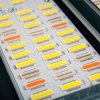Hey SDS, how's it hangin'?

Thanks for the info. Again!

Actually I'm reading it now and it's got lots of studies I missed. It would make a great sticky/primer for noobs and novices alike, maybe a little light on the COB and white info, but still good solid SCIENCE based (Hi PF

) primer.
I'm interested to see if Illumitex dumped the 5000K from the F3 line with the F3A. RGB +730nm does make sense and opens up the possibility of having control over at least the RGB portion and would be completely killer if you can control the 730nm too, especially for perpetual growers who could turn it off during the stretch when introducing a new plant, though on the F3 I believe FR only encompasses 1 or 2 % of the total beam content and may not be that big of contributor to excess stretch. Then again you really don't need that much FR, (or do we? LOL) to begin with so it might contribute to stretch significantly. God I'm confusing myself now! LOL And another great aspect is the ability to control the green percentage and try to find out the amount MMJ likes and how much retards growth, as excess green can in certain situations I've been led to believe.
And another big question is, (Hi ChazB), is the Aurora getting a UL listing? I mean if it's a real replacement it's gotta have that and a few other ratings to be accepted in the US, right? I just can't see Illumitex dropping the ball on that account, but who knows what UL is going to say.
Questions SDS, always questions. Sigh. Can they freeze me and wake me up in 50 years? I bet PSU.jr will be here telling me what's what! LOL Then again, HAIL DISCOVERY and all her rewards. Nothing like getting in from the beginning, right boss?
Oh yeah, I started to read that MIT report a few days ago and these lines just stopped me in my tracks, "
They calculate that the cumulative cost of high pressure sodium lamps surpasses that of LEDs after just 7 years and that after 16 years the cumulative cost of high pressure sodium lamps is more than double the equivalent cost of LEDs." I would love to see how they came up with that number. I'm thinking that's just pulling numbers out of your ass to prove a point type logic and thinking. In 7 years you're gonna lose some output. Output that might cost a business significant money or damage one's reputation. You think they included lumen deprecation? Or the failure rate of your drivers? I don't think they did those numbers or at least I don't think they want to talk about them. And how do you get a sales department to use that as a selling point?
And this one too is a killer to me, "Although high pressure sodium lamps are individually cheaper than LEDs
, they have to be changed every year compared to every 19 years for LEDs." 19 years! WTF! In 19 years you'll be getting 10+ grams a watt or something crazy insane, (quick someone do Haitz's Law to see where LEDs are in 19 years). My respect for MIT just went down a bit.





